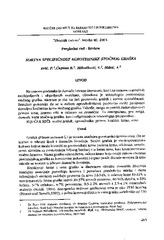Приказ основних података о документу
Production technology of fodder pea in terms of cultivar specificity
Sortna specifičnost agrotehnike stočnog graška
| dc.creator | Erić, Pero | |
| dc.creator | Ćupina, Branko | |
| dc.creator | Mihailović, Vojislav | |
| dc.creator | Mikić, Aleksandar | |
| dc.date.accessioned | 2021-04-26T18:02:25Z | |
| dc.date.available | 2021-04-26T18:02:25Z | |
| dc.date.issued | 2004 | |
| dc.identifier.issn | 0354-7698 | |
| dc.identifier.uri | http://fiver.ifvcns.rs/handle/123456789/255 | |
| dc.description.abstract | According to data from foreign and domestic references as well as original unpublished and published results, production technology of fodder pea has been discussed. Spring protein pea in terms of cultivar specificity is emphasized. Selection of fodder pea variety for specific agroecological conditions is of particular importance, as the cultivar significantly influences the production technology. The best preceding crops for winter fodder pea are small grains, while sunflower, corn (attention should be pay to herbicides) and sugar and fodder beet are the best previous crops for winter genotypes. In the agroecological conditions of the Vojvodina Province the optimum sowing date for winter varieties (NS-Dunav and NS-Pionir) is from September 20th until October 10th For spring common grain and grain dwarf varieties (NS-Junior, Jezero, Moravac and Javor) the optimum dates are from February 1st until 15th of March. If weather conditions allow, sowing can be done earlier. It should be underlined that grain yield and quality greatly depend on sowing date. The optimum crop density, i.e. number of plants, for winter varieties ranged from 100-120 plants per m2, and for spring cultivars from 60 to 100 plants per m2. The number of plants per unit of area depends on the purpose of fodder pea growing (grain or forage). Fertilization depends all on soil properties (fertility) and fodder pea cultivar as well. Dwarf grain varieties are more tolerant of higher nitrogen levels. Forage pea varieties with colored flower (NS-Dunav, NS-Pionir and NS-Lim) are rarely prone to pea weevil attack (only in particular conditions/years/growing seasons). Protection from mentioned pest can be done in the storehouse. | en |
| dc.description.abstract | Na osnovu podataka iz domaće i strane literature, kao i na osnovu orginalnih neobjavljenih i objavljenih rezultata, obrađena je tehnologija proizvodnje stočnog graška. Akcenat je dat na jari proteinski grašak i sortne specifičnosti. Rezultati pokazuju da se u našem agroekološkom području može proizvesti dovoljno kvalitetne krme stočnog graška. Takođe, mogu se postići zadovoljavajući prinosi zrna, znatno više u odnosu na prosečne. To omogućuju, pre svega, domaće sorte stočnog graška, kao i odgovarajuća tehnologija proizvodnje. | sr |
| dc.publisher | Institut za ratarstvo i povrtarstvo, Novi Sad | |
| dc.rights | openAccess | |
| dc.source | Zbornik radova Instituta za ratarstvo i povrtarstvo | |
| dc.subject | fodder pea | en |
| dc.subject | production technology | en |
| dc.subject | yield | en |
| dc.subject | quality | en |
| dc.subject | forage | en |
| dc.subject | seed | en |
| dc.subject | stočni grašak | sr |
| dc.subject | agrotehnika | sr |
| dc.subject | prinos | sr |
| dc.subject | kvalitet | sr |
| dc.subject | krma | sr |
| dc.subject | zrno | sr |
| dc.title | Production technology of fodder pea in terms of cultivar specificity | en |
| dc.title | Sortna specifičnost agrotehnike stočnog graška | sr |
| dc.type | article | |
| dc.rights.license | ARR | |
| dc.citation.epage | 417 | |
| dc.citation.issue | 40 | |
| dc.citation.other | (40): 405-417 | |
| dc.citation.spage | 405 | |
| dc.identifier.fulltext | http://fiver.ifvcns.rs/bitstream/id/1110/252.pdf | |
| dc.identifier.rcub | https://hdl.handle.net/21.15107/rcub_fiver_255 | |
| dc.type.version | publishedVersion |


